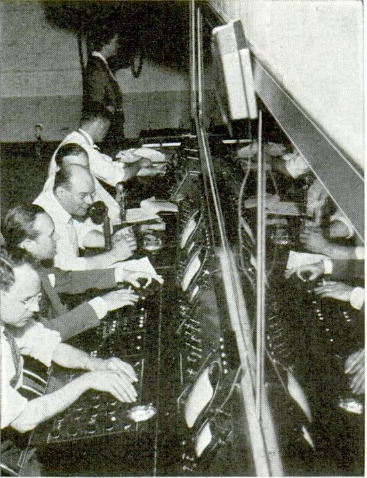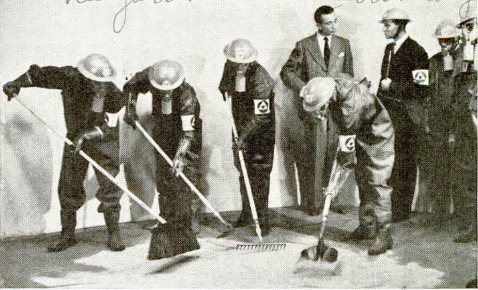YANKEE mass production, which is pouring billions of dollars worth of American guns, tanks and ships into the world conflict has another accomplishment to its credit - the mass production of expert defense workers through the medium of television. Thousands of civilian defense volunteers, firemen and policemen within a radius of 50 to 75 miles of New York City, Philadelphia, Schenectady, N. Y., and Los Angeles are literally snatching from the air the training necessary to their roles as soldiers of the home front. The nation’s sudden entry into the conflict found its cities with plenty of volunteer workers, but few instructors capable of training them. At the rate they were being taught, months and perhaps years would have been necessary to train enough experts in the science of fighting a war which has no front lines and no impregnable defense points. The small group method of teaching was proving interminably slow in cities along the coasts faced with the threat of bombing almost any day. An experiment in the form of a unique war school, a school with classrooms scattered around New York City in police stations, fire houses, school auditoriums, private homes and radio dealers’ shops, gave an answer to the problem of civilian preparedness. The first broadcast was in the nature of a test by the National Broadcasting Company with only 130 of the city’s 5,100 television receivers in use. So successful was the television method in this test that hundreds more sets were pressed into use and the classrooms were extended into New Jersey, Connecticut and Pennsylvania. The Columbia Broadcasting System, which had been devofing a portion of its television programs to helpful war subjects, took over the task of educating the public to its defense dutie. Vastly expanded, these two television militarytraining schools are filling the air not only with in- structions intended to make America warwise, but with actual demonstrations of what is expected both of volunteers and the public. The lessons deal with such subjects as the extinguishing of incendiary bombs and the treatment of poison gas victims. The teaching instruments are lectures, the demonstration laboratory and televised motion pictures, many of which are made for the express purpose. A typical National Broadcasting course for volunteer defense soldiers would include a first lesson on the general duties of an air-raid warden, a second on the fire bomb, a Fighting a “fire third on what to do in blackouts, a fourth on gas warfare and two sessions in which the important points are reviewed. Television’s illustrations for the lessons have all the graphic and moving appeal of a Hollywood production. The first on NBC had Maurice Wells, as Post Warden “Arthur Smith,” directing pedestrians to shelter and halting traffic on a street scene during an imaginary raid. The second lesson depicted a “bombing” of Times Square with the assistance of actors, stage sets, sound effects and motion pictures. The “Browns,” television’s typical New York family, also fought a fire bomb that fell into their apartment during the “raid.” In each of the NBC lessons, which are repeated eighteen times a week, a uniformed member of the staff of the Coordinator for Police Department Civilian Defense faces the electric cameras in the National Broadcasting Company’s sight-sound studios at Radio City. He tells the points to be covered in the lesson. At intervals other cameras bring the words of the defense expert to life with dramatized demonstrations of rules laid down by the Office of Civilian Defense. For 30 minutes wardens follow the theatrical presentation on their sets. Then, after the telecast is over, they discuss the lesson under the leadership of the precinct defense officer. Nothing like this had ever been attempted before anywhere in the world. It is something new, not only in radio, but in education. And its success in practice pretty much parallels its daring in conception. Typical of the CBS program was a replica of the heavily guarded information center “somewhere in New York,” set up in front of the television cameras. This is the permanent nerve center of the air defense of the northeast quarter of the United States. How it operates under bombing conditions was demonstrated from the first warning telephone flash of approaching raiders, through the order for antiaircraft searchlights and barrage-balloon defense, to the dispatching, navigation, and control of the interceptor planes that do battle with the enemy before it gets a chance to bomb the city. As information of approaching aircraft was phoned to the “center” by observers from Maine to Carolina, the television audience saw some of the 3,000 civilian volunteers go into action. The course of the attacking planes was carefully mapped by the volunteers, who directed the interceptor planes until the squadron leader reported “enemy sighted.” The squadron leader was then on his own. The system is patterned after that developed by the British. But the United States is not only adapting British methods to its own use, but is passing on to the British air-raid protection techniques developed here. Some of the lessons are dramatized to show what should be done in the event of an attack on an American city. In other cases, an instructor goes before the television camera to address the householder something like this: “Go around the house to see that no lights, visible from the outside, are left burning. All gas lamps and, if possible, the gas at the meter, should be turned off to reduce danger of explosion. Do not use more open-flame lights in the ‘refuge room’ than necessary, but any amount of shielded electric lights is permissible. “Do whatever else your own common sense indicates is necessary, and then, after making certain that every one and everything needed is at hand, close the door and seal it if there is any possibility that gas might be used.” Or, regarding traffic regulations during a raid: “During raids, all except essential vehicles should stop, leaving two lanes in the center of streets clear. They should not park closer than 25 feet to intersections and should leave at least 25 feet of curb clear on both sides of any fire hydrant. Specialized training is also televised for fire watchers, rescue squads, messengers and drivers. In the case of the special lessons, a list of questions is sent to all civilian defense “schoolrooms” and the person in charge, usually a policeman or fireman, asks questions from the list to ascertain how well the lesson was learned. Since “live” demonstrations, motion pictures, slides, maps, lectures and round table discussions may be included in a single hour’s session on the television stage, a staff of more than 50 experts is often needed to put on one show. An example is this program: Beginning with a vivid motion picture of incendiary bombs raining down on London, the program switched to New York for sequences dealing with the insignia of air raid wardens, the warning flashed to interceptor command headquarters upon the appearance of enemy planes, siren alarms, the duties of senior and post wardens, and the system by which the city is divided into precincts, zones and sectors. Gathered in the NBC television studios in Radio City more than twenty wardens, men and women, asked and answered questions concerning civilian behavior during a raid. A police lieutenant answered questions the wardens missed. Observers of the show were advised to keep out of subways in case of a raid, to seek shelter in the nearest building or to lie down on the ground if no shelter is near, to lock up pets, and not to gape at aerial combats. Demonstrations also show how to handle injured persons with fractured bones, how to control bleeding, how to apply artificial respiration, how the “iron lung” is used, and even dramatize the proper way of caring for hot water bottles, gloves, boots, swimming suits, hoses and other precious rubber products. The result is that Americans in the television zones are rapidly becoming wise in the ways of the war ridden world. They want to be shown, and television is showing them.




